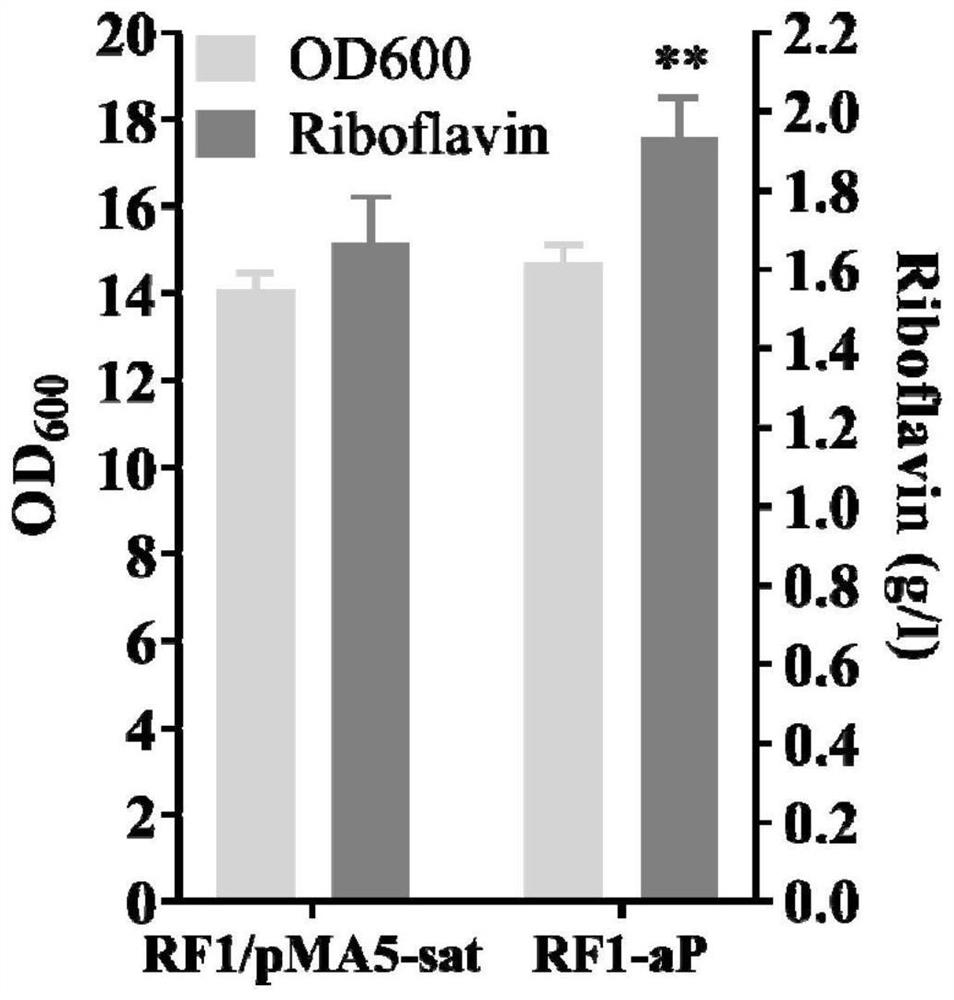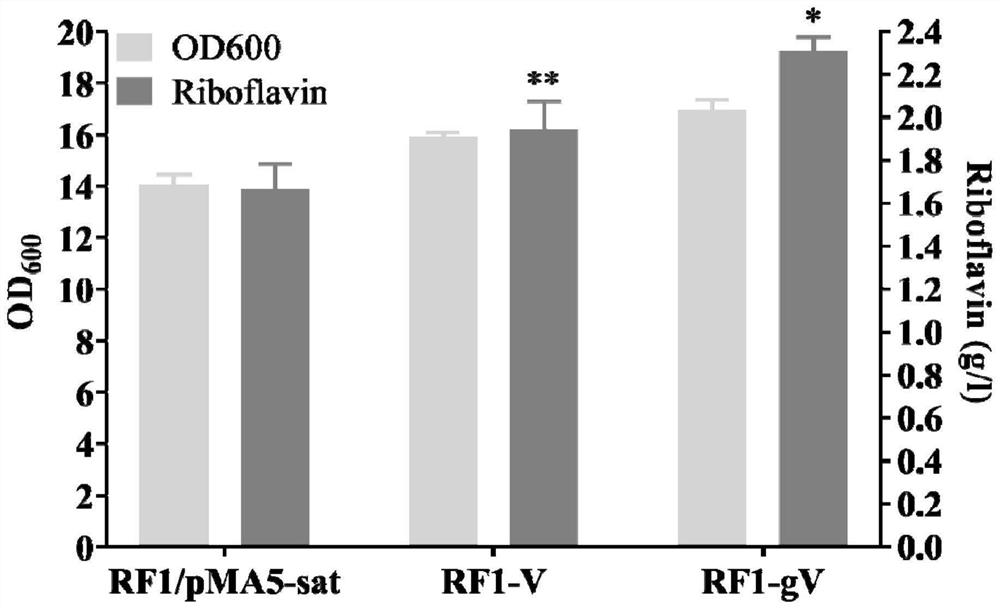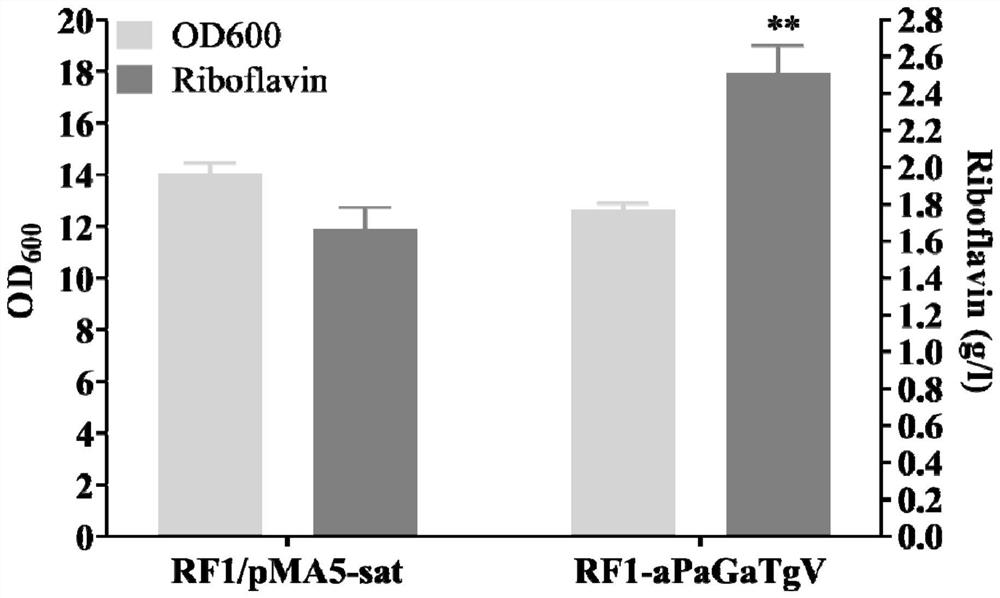Genetically engineered bacterium for efficiently synthesizing riboflavin and application of genetically engineered bacterium
A technology of genetically engineered bacteria and riboflavin, applied in the direction of genetic engineering, application, plant genetic improvement, etc., can solve problems such as differences in gene expression levels
- Summary
- Abstract
- Description
- Claims
- Application Information
AI Technical Summary
Problems solved by technology
Method used
Image
Examples
Embodiment 1
[0049] Embodiment 1: Construction of engineering strain RF1-aP
[0050] The gene purR is knocked out from the genome by means of homologous recombination, and the repression of purine metabolism in the cell is released.
[0051] Specific steps are as follows:
[0052] (1) Amplify the upstream homology arm (1000bp) and downstream homology arm (1000bp) of the gene purR according to the primer sequences in Table 1, and separate the PCR product by agarose gel electrophoresis, and cut the gel to recover the target PCR product. Then the homology arm was fused with the knockout Marker by fusion PCR strategy. First, the upstream and downstream fragments were mixed at a volume ratio of 1:1, and an equal volume of PCR enzyme was added to carry out a fusion PCR reaction. The conditions were 98°C for 3min, 98°C for 8s, 61°C for 5s, and 72°C for 2min, and amplified for 13 cycles. The product after the first step reaction is used as a template, and the fusion fragments are amplified using...
Embodiment 2
[0055] Embodiment 2: Construction of engineering strains RF1-aG and RF1-aT
[0056] Place the antisense strands of the genes glnR and tnrA in the strong promoter P 43 Overexpressed under control, the antisense RNA is complementary to the mRNA of the normally expressed genes glnR and tnrA in the cell, thereby preventing the normal translation of GlnR and TnrA and regulating the nitrogen metabolism level in the cell. Inhibition of translation of glnR and tnrA genes by an antisense RNA strategy. Promoter P 43 The antisense RNA of the control genes glnR and tnrA was used to construct engineering strains RF1-aG and RF1-aT.
[0057] Specific steps are as follows:
[0058] 1. Preparation of genetic engineering strain RF1-aG
[0059] (1) Using primer P 43 - AntiglnR-F1 and P 43 - AntiglnR-R1 amplified gene P 43 , primer P 43 -AntiglnR-F2 and P 43 -AntiglnR-R2 amplifies the gene glnR, recovers and purifies the target fragment by agarose gel electrophoresis, then mixes the targ...
Embodiment 3
[0063] Embodiment 3: Construction of engineering strain RF1-gV
[0064] In the process of metabolic modification of industrial microorganisms, VHb is often used to alleviate the dissolved oxygen limitation in the fermentation process and increase the yield of target products. In order to avoid the burden of exogenous gene overexpression on cells and the damage of cells by oxidative stress, a dynamic regulation strategy was used to control the expression of gene vgb.
[0065] Specific steps are as follows:
[0066] (1) with primer P glnR -gfp-F1 and P glnR -gfp-R1 amplifies the promoter sequence of gene glnR and recovers and purifies, then primer P glnR -gfp-F2 and P glnR- The gene gfp sequence amplified by gfp-R2 was recovered and purified, and the above two fragments were mixed at a volume ratio of 1:1, and then PCR enzyme was added for overlapping PCR reaction. The reaction conditions were 98°C for 3min, 98°C for 8s, and 61°C 5s, 2min at 72°C, 13 cycles of amplification...
PUM
 Login to View More
Login to View More Abstract
Description
Claims
Application Information
 Login to View More
Login to View More - R&D
- Intellectual Property
- Life Sciences
- Materials
- Tech Scout
- Unparalleled Data Quality
- Higher Quality Content
- 60% Fewer Hallucinations
Browse by: Latest US Patents, China's latest patents, Technical Efficacy Thesaurus, Application Domain, Technology Topic, Popular Technical Reports.
© 2025 PatSnap. All rights reserved.Legal|Privacy policy|Modern Slavery Act Transparency Statement|Sitemap|About US| Contact US: help@patsnap.com



